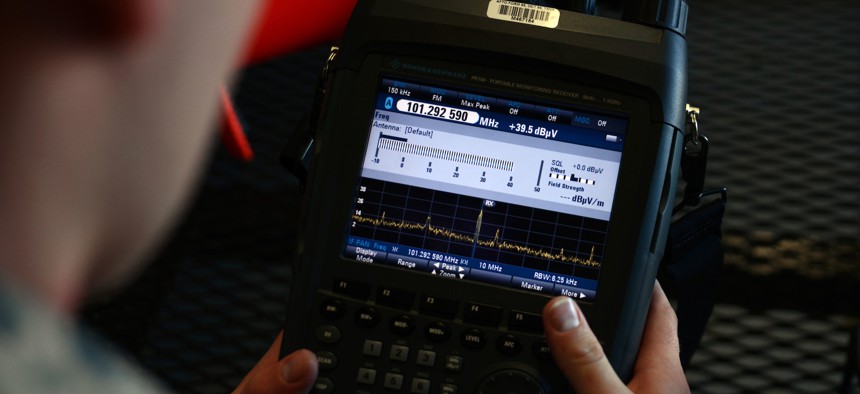
U.S. Air Force Staff Sgt. Geoffery Smith, 20th Communications Squadron installation spectrum manager, views the display on a radio spectrum analyzer at Shaw Air Force Base, S.C., Jan. 13, 2017. U.S. Air Force photo by Airman 1st Class Kathryn R.C. Reaves
The Pentagon Is Ill-Organized to Improve Its Use of Electromagnetic Spectrum, GAO Says
Old ways and means are quickly becoming obsolete — but spectrum issues remain everyone’s second job.
The U.S. military has big plans for better harnessing the electromagnetic spectrum, but lacks the organizational setup to do it, says the Government Accountability Office, or GAO. The department hasn’t even figured out who should be in charge of implementing its months-old strategy, let alone how to connect or combine the service’s many related projects and efforts.
“DOD officials from multiple offices with [electromagnetic spectrum] duties identified a lack of central coordinating authority as a major challenge to effective EMS governance,” says the report, issued on Thursday. “An official from the [cross-functional team] said that EMS-related duties are spread across the department and there is a need for a DOD official that can be held responsible for EMS issues.”
The problem isn’t so much a lack of high-ranking defense officials with eyes on electronic warfare and spectrum issues. It’s that those people have a lot of other important things to do, so while they may all agree that spectrum warfare is critical and that the Defense Department should follow its own strategy, they’re also in charge of things like nuclear deterrence or fixing the Defense Department’s information technology infrastructure. So spectrum issues become everybody’s second job.
“Senior-level DOD officials responsible for department-wide EMS management are assigned many non-EMS-related responsibilities. For example, the Vice Chairman of the Joint Chiefs of Staff, a four-star general officer, is DOD’s Senior Designated Official for the [cross-functional team] but has numerous other responsibilities,” notes the report. “Those who focus on EMS-related issues full-time are most often located at lower organizational levels within DOD.”
Some of the hardware that the Defense Department is using remains “fundamentally unchanged in design since they were fielded decades ago,” which, in addition to being obsolete, aren’t interoperable with newer pieces of equipment or allied hardware.
Overly bureaucratic buying practices are another obstacle, the report said.
It comes at a time when the Defense Department is changing how it approaches electromagnetic warfare.
For instance, the Department is developing electronic warfare teams called Joint Electromagnetic Spectrum Operations Cells, or JIMSOCs, which the Department hopes to embed with combatant commands. These cells will use a new planning-and-situational awareness tool, dubbed Electromagnetic Battle Management, being developed by U.S. Strategic Command and the Defense Information Services Agency. “We are using a rapid software acquisition process to acquire” the tool, STRATCOM’S Brig. Gen. AnnMarie Anthony said Thursday during a Mitchell Institute webinar.
Spectrum warfare tools have changed dramatically in recent years, with innovation moving away from hardware toward software-defined radio whose code-based mixers and detectors can quickly adjust and shift between frequencies. That makes it easier to purchase EO hardware that can perform more than one function, which is changing the way the Defense Department buys that equipment, said David Tremper, who directs electronic warfare at the Office of the Secretary of Defense. “Diifferent services are taking that multi-function approach. There’s an acquisition impact we have to assess. We are taking a close look at that,” Tremper said in the webinar.
The emergence of software-defined networking and new digital spectrum tools, if the Department and operators can embrace them, will do much to address issues like interoperability and slow acquisition, since software can always be reprogrammed to suit different needs.
“Imagine a world where everything is increasingly software-defined radio or a reprogrammable multifunctional array and then you build an organization that is capable of presenting new capability by composing what you’ve got in new ways but not messing with the underlying...hardware,” said Col. William Young with the 350th Spectrum Warfare Wing. “Now you have the opportunity to rapidly deliver new capability.…We can create software to solve a problem that may not be enduring.”
